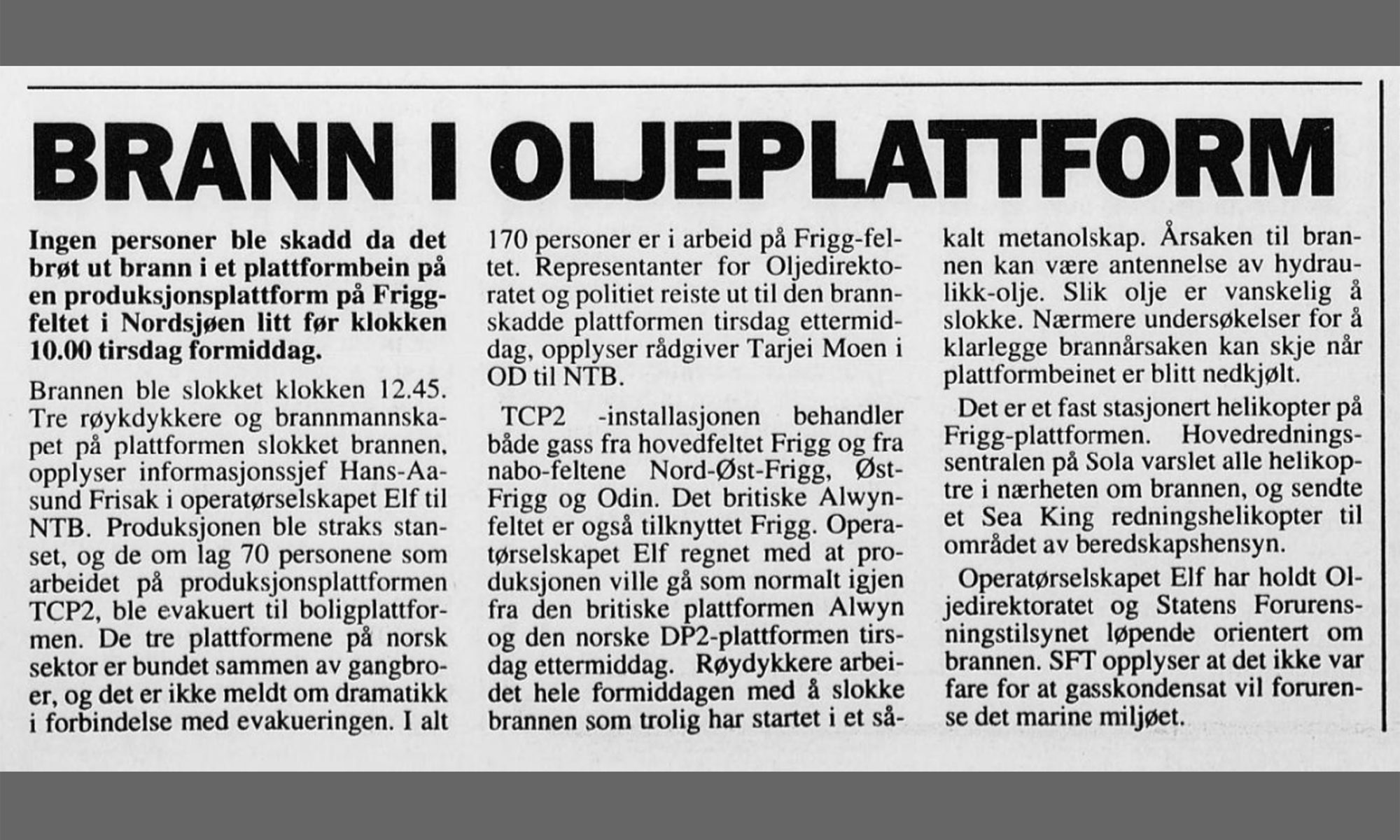Fire in a shaft

This blaze began during welding work 30 metres down in the concrete shaft, where a new riser for gas and condensate from Lille-Frigg was to be installed. The same shaft accommodated the gas and condensate risers from East Frigg, North-East Frigg and Odin, plus an umbilical with hydraulic oil and methanol lines to East Frigg. Leaks from a methanol tube had been observed on several previous occasions, with fires breaking out no less than three times during October.
The relevant faults had been corrected each time. The umbilical contained 10 tubes, five for methanol, four for hydraulic oil and one spare. These were used to transport methanol (anti-freeze) for injection into the East Frigg gas, and hydraulic oil to control the modules. The leaks had arisen because small methanol molecules had penetrated the tube walls and accumulated in the umbilical. Pressure had then forced this methanol back to TCP2, where it leaked out in the connection box where the umbilical was clamped to a riser leading up to the topside.
Extensive safety measures were instituted because welding to install the Lille-Frigg riser was to be carried out close to this connection box.
A screen of steel plates was initially installed as a barrier between the welding area and the methanol drain tank and control panel. Fire-retardant mats were then laid to cover any cracks between the floor and the lower part of the steel screen. A tarpaulin was hung between the connection box and the welding area, while the floor was also covered with foam to prevent fires.
Despite these extensive safety measures, the tarpaulin caught fire. Methanol had leaked from the connections between the umbilical and the pipeline, and out into the box. Since methanol is heavier than air, it had accumulated under the tarpaulin and been ignited by welding sparks. The investigation report compiled after the fire determined that the tarpaulin deployed as a safety measure contributed to the development of the blaze. The fireguard on duty at the site first spotted a flame between the tarpaulin and the connection box. He attempted to extinguish the fire with foam.
At the same time, further bluish flames emerged from the rear of the box. Efforts were also made to put these out with foam. By then, welding had ceased. Flames four-five metres high suddenly sprang up and the tarpaulin first began to melt and then to burn. Another fireguard who was in the area arrived, the alarm was sounded and the shaft evacuated. The fire was now out of control.
In an attempt to douse the flames, large volumes of water and foam were poured over the fire site from the platform topsides, 30 metres above. This distance proved too great for effective firefighting. The water curbed but did not extinguish the flames. Thick clouds of smoke made it difficult for the smoke divers to reach the site of the fire and pinpoint its exact location. However, this was accomplished by the second smoke diving team to go down the shaft.
The flames were reduced as water was poured on directly. As soon as the water was removed, however, the fire flared up again. A third smoke diving team managed to remove the shielding plates and tarpaulin with the aid of a boathook, and water was against sprayed directly on the site of the fire. This time, the flames were put out for good. That occurred 90 minutes after the fire started. Another hour and a half was needed to ensure that the blaze was thoroughly extinguished.
It was quickly established that the blaze could not spread and that nobody was hurt. A rescue helicopter from 330 squadron at Stavanger’s Sola airport had nevertheless been scrambled in case complications arose. In addition, the joint rescue coordination centre for southern Norway had notified all vessels and helicopters in the area to be on standby. Elf had its own emergency response helicopter ready, and the Normand Skipper standby ship constantly sprayed water over the concrete shaft from the outside to cool it down.
Gas production from the whole Frigg field shut down immediately when the alarm sounded. TCP2 was out of commission for a period, but TP1 came back on stream the following day. Damage on TCP2 was confined to the site of the fire.
This article is based on the report prepared after the fire: Accident Investigation Report, Fire in Column 5, Nov 10th, 1992, issued by Elf Petroleum Norge AS.
Company name changesShutdown of North-East Frigg